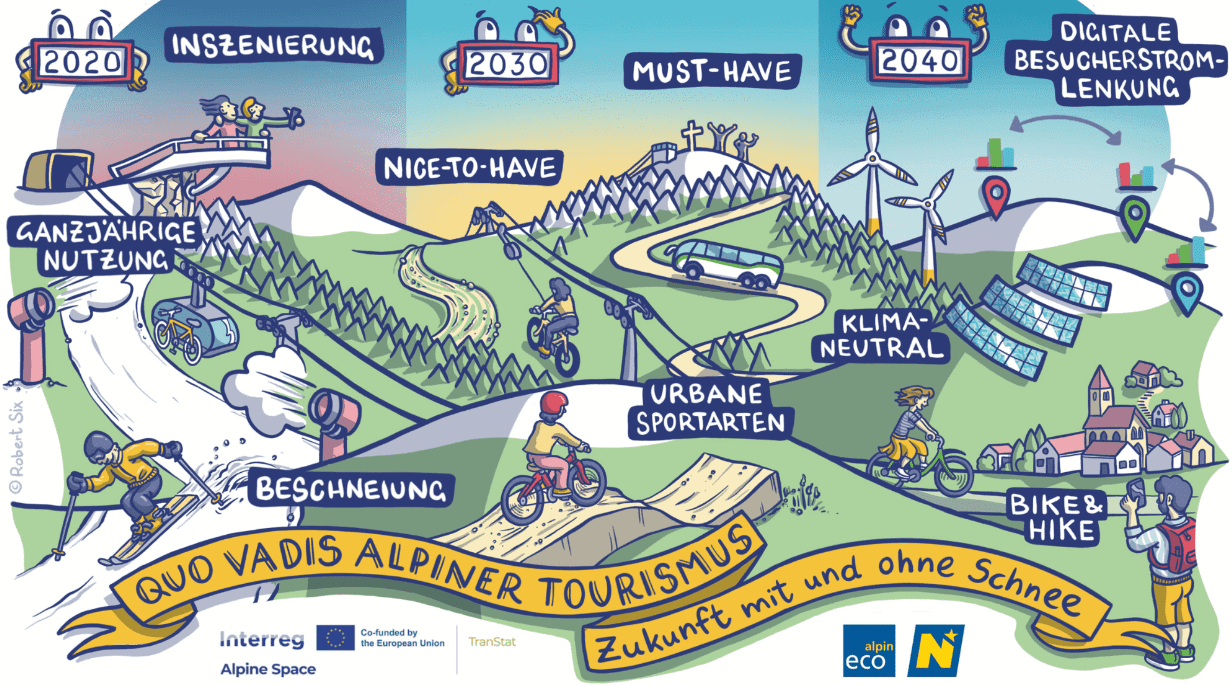Author: Markus Redl – Ecoplus Alpin
In the ongoing transformation process in ski resorts, it is also important to reduce complexity. To get it down to the point, to get into conversation and to shape the future of ski resorts or mountain resorts operating all year round. A total of nine visions of the future will help – three from 2020, 2030 and 2040.
2020
1. Technical snowmaking
This truly successful adaptation strategy has become much more effective over the decades. In addition, modern snow management in the form of increasingly sophisticated methods (snow height measurement, snow farming, etc.) helps to manage with scarce resources such as water or affordable energy in many places. Ultimately, however, there are limits to what is technically feasible and economically sensible at a given (micro) location. As an indicator of this, the altitude with secured snow cover build-up (natural snowfall limit) varies greatly in Austria depending on the air masses, which are mainly responsible for precipitation in the respective regions. Local current conditions or – in case of heavy rain – even geology have a major influence.
2. Production
Especially in summer, the tourist experience in the mountains has become barrier-free in the real and figurative sense thanks to the (cable car) infrastructure. Not everyone can walk up the mountain or ride a bike. The quality network Best Austrian Summer Mountain Railways shows many positive examples of staging, that is a pre-structured, mountain experience that is as stimulating as possible for guests with their special needs, often instructive and hopefully always safe. Even in winter, attractions such as funslopes can provide excitement and variety and help to steer the flow of visitors. In the best-case scenario, one and the same infrastructure can be prepared for different target groups by means of variants in the staging. Because strategically, it is important to benefit as many people as possible with as little space consumption or other interventions as possible.
3. Year-round use of infrastructure and superstructure
Tourism in the Alps has historically been closely linked to the construction of railway lines in Switzerland, Austria and Upper Bavaria. It is no coincidence that many tourist destinations from St. Anton am Arlberg to Semmering have been ideally served by rail since the end of the 19th century. At that time, summer was the main alpine season, with the famous summer freshness, there were also long-term stays, especially in the vicinity of big cities. After the Second World War, the holiday with your own car began to dominate and while various summer destinations away from the Alps were successful, winter or ski tourism became a cash cow. This pendulum is swinging back, there are hardly any places or accommodation establishments that rely only on the winter season – operating closures are getting shorter.
2030
4. Strategic concentration of the “must-have” snow sports offer
By far the most important question – which all alpine destinations with relevant ski tourism must ask themselves in their own way – is which specific slopes are chosen as a minimum offer. What is the respective “residue” that is needed to satisfy guests with snow sports? Where should the Christmas holidays be secured? Every reduction of the piste area to be snowed increases the impact of the snow-making system and makes it possible to provide basic snow in a short time. This strategic decision to focus on the “must-have” is intended to enable a concerted approach in the destination or small region, especially in the area of local mobility. How do guests who do not (any longer) stay ski-in/ski-out get to the slopes and back again? Which feeder railways and possible valley descents are there?
5. Particular flexibility in the “Nice-to-Have” snow sports offer
For today’s conditions, a hybrid operation, i.e. simultaneous winter and summer offer, seems exotic. But this kind of flexibility, to use infrastructure such as a cable car several times, could teach. Currently, this is hardly conceivable from the operational processes, but if, for example, there is no or not enough snow in some areas, then selected bike trails, children’s playgrounds, hiking trails, via ferrata etc. remain in operation (temporarily or permanently) in winter. In some places, the focus on the “must-have” will also be accompanied by (partial) dismantling or re-use of existing (winter) infrastructure. Conversely, new (summer) infrastructure – such as a bike lift – could also be used in winter for snow sports.
6. Urban forms of movement such as roller sports as an opportunity for young people
For climbing, the transfer from the climbing hall to the mountain should work. In any case, the alpine clubs recognized this opportunity to recruit new mountaineering enthusiasts (and members) some time ago. Climbing halls with boulders and toprope safety systems lead to climbing gardens, via ferrata and finally the entire spectrum of alpinism. It could work similarly with “roll sports”, because parks for skateboards, scooters and BMX are very popular in the urban environment. From the pumptrack it could go towards the trail park on the mountain. Which has the charm of being well anchored in youth culture. Snow sports should also focus much more on freeskiing, parks for skiing and snowboarding should be created directly in the cities with dry slopes. From there it would go to action parks like those of Woodward.
2040
7. Digitally supported visitor power steering for “optimal” utilization
Just because of the relative “coolness”, the abundance of water and the (hopefully) good public accessibility, demand will increase. The Alps become so attractive for holidays and excursions that a certain channelling is absolutely recommended. In terms of nature conservation, the principle of the ski resort is highly attractive, far superior to an “uncontrolled” use of the cultural landscape. Infrastructures such as hiking trails or bike trails or ski slopes or cross-country skiing trails – including associated catering, equipment rental, etc. – are to be optimally utilized. Temporary overloads are unacceptable for reasons of safety, comfort and job satisfaction, just as massive overcapacity cannot be maintained for economic reasons alone. The solution is digital marketplaces, which organise supply and demand – well-matched for different services.
8. ‘Bike & Hike’
This does not primarily mean the special form of play, in which you travel by bicycle to the mountain or even ski tour. But the entire, already highly differentiated spectrum of activities around hiking and biking on the mountain. Particularly attractive among all variations are those that can be operated (almost) all year round and also require a simple and energy-intensive infrastructure as possible. Gravel biking, for example, is still a relatively new discipline, in which – as the name suggests – gravel roads of all kinds are cycled. The industry has recognized the potential and offers a combination of road bike and mountain bike, of course also electromotorized, with which selected forest roads can be used ideally. More walking and cycling, especially in everyday mobility, thus finds its equivalent in holidays and leisure time.
9. Climate neutrality
We for all social and economic sectors also apply to tourism in the Alps, of course, to achieving a balance between greenhouse gas emissions and the uptake of carbon dioxide from the atmosphere in carbon sinks (such as forests!). Both legislators and potential guests will expect net-zero emissions, and corresponding instruments such as Environmental Social Governance (ESG) will become standard. The objective of climate neutrality requires the circular economy to be considered as a new paradigm and to focus much more on the production of renewable energy. In the tourism industry, we will not be able to avoid the Gretchen issue of guest mobility (including travel to and from) either.



